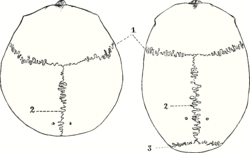Calvarium
| Calvaria (skull) | |
|---|---|
 |
|
| Details | |
| Identifiers | |
| Latin | calvaria |
| Dorlands /Elsevier |
c_03/12206548 |
| TA | A02.1.00.032 |
| FMA | 52800 |
|
Anatomical terms of bone
[]
|
|
The calvaria or skullcap (feminine Latin noun with plural calvariae; however, many medical texts list the word as calvarium, neuter Latin noun with plural calvaria) is the upper part of the neurocranium and covers the cranial cavity containing the brain.
The calvaria (skullcap) is made up of the superior portions of the frontal bone, occipital bone, and parietal bones. In the human skull, the sutures between the bones normally remain flexible during the first few years of postnatal development, and fontanelles are palpable. Premature complete ossification of these sutures is called craniosynostosis.
The outer surface of the skull possesses a number of landmarks. The point at which the frontal bone and the two parietal bones meet is known as "Bregma". The point at which the two parietal and occipital bones meet is known as "Lambda". Not only do these landmarks indicate the fontanelle in newborns, they also act as reference points in medicine and surgery.
The inner surface of the skull-cap is concave and presents depressions for the convolutions of the cerebrum, together with numerous furrows for the lodgement of branches of the meningeal vessels. Along the middle line is a longitudinal groove, narrow in front, where it commences at the frontal crest, but broader behind; it lodges the superior sagittal sinus, and its margins afford attachment to the falx cerebri. On either side of it are several depressions for the arachnoid granulations, and at its back part, the openings of the parietal foramina when these are present.
It is crossed in front by the coronal suture and behind by the lambdoid suture, while the sagittal suture lies in the medial plane between the parietal bones.
...
Wikipedia
